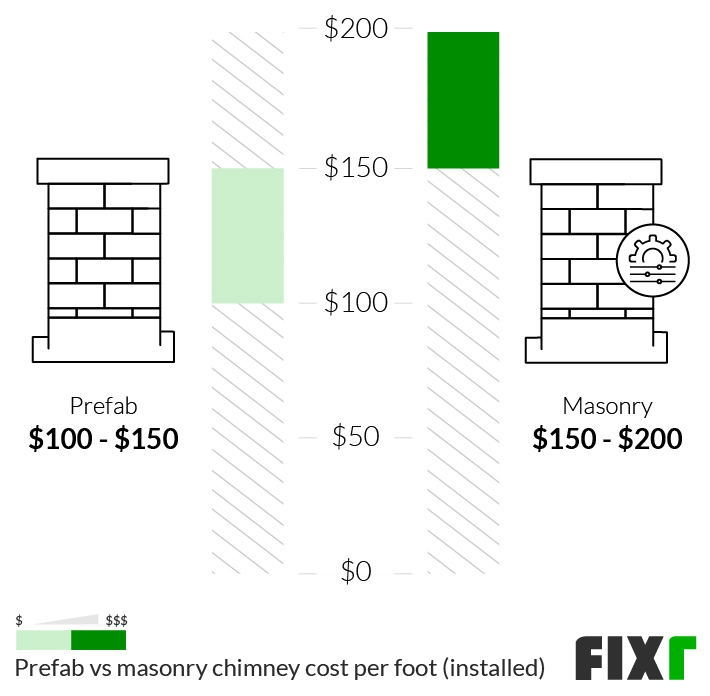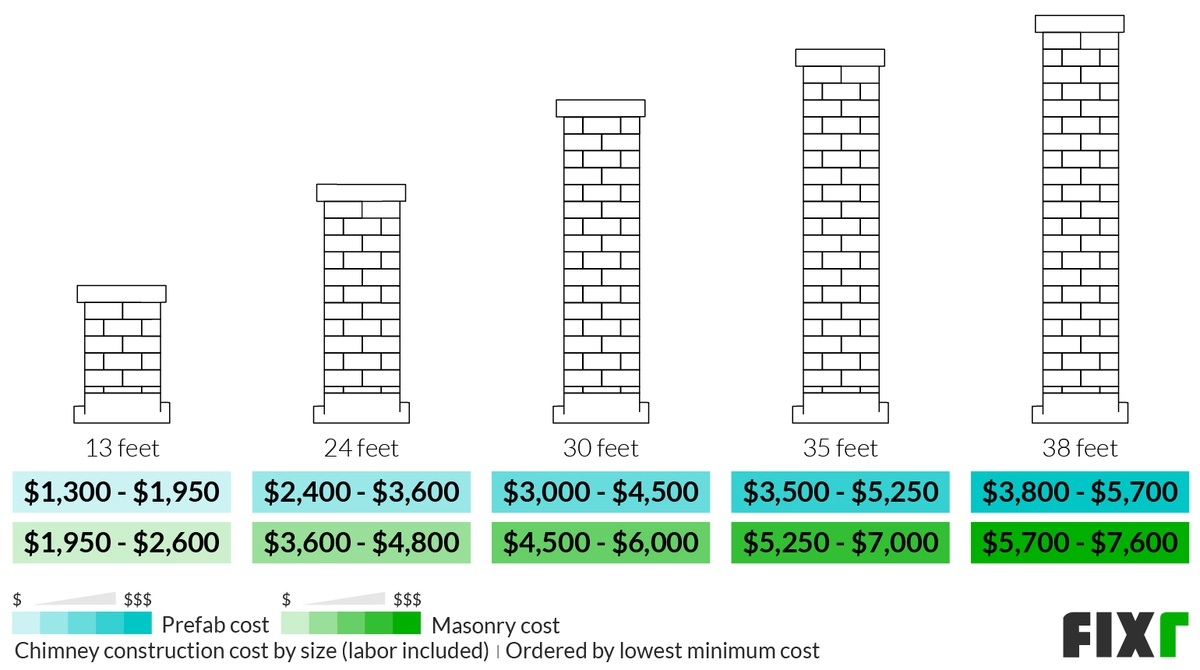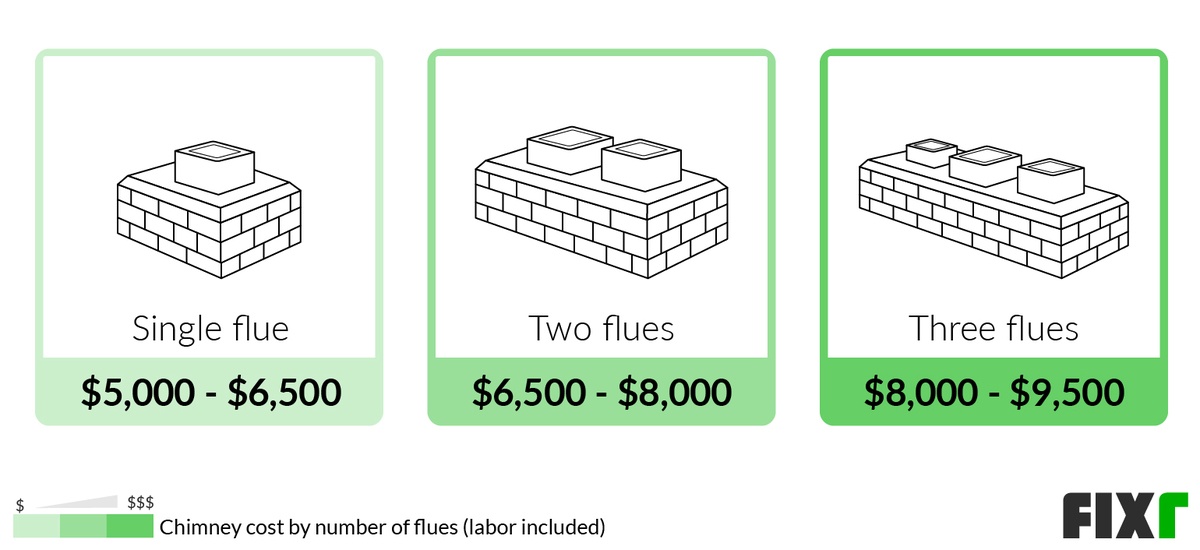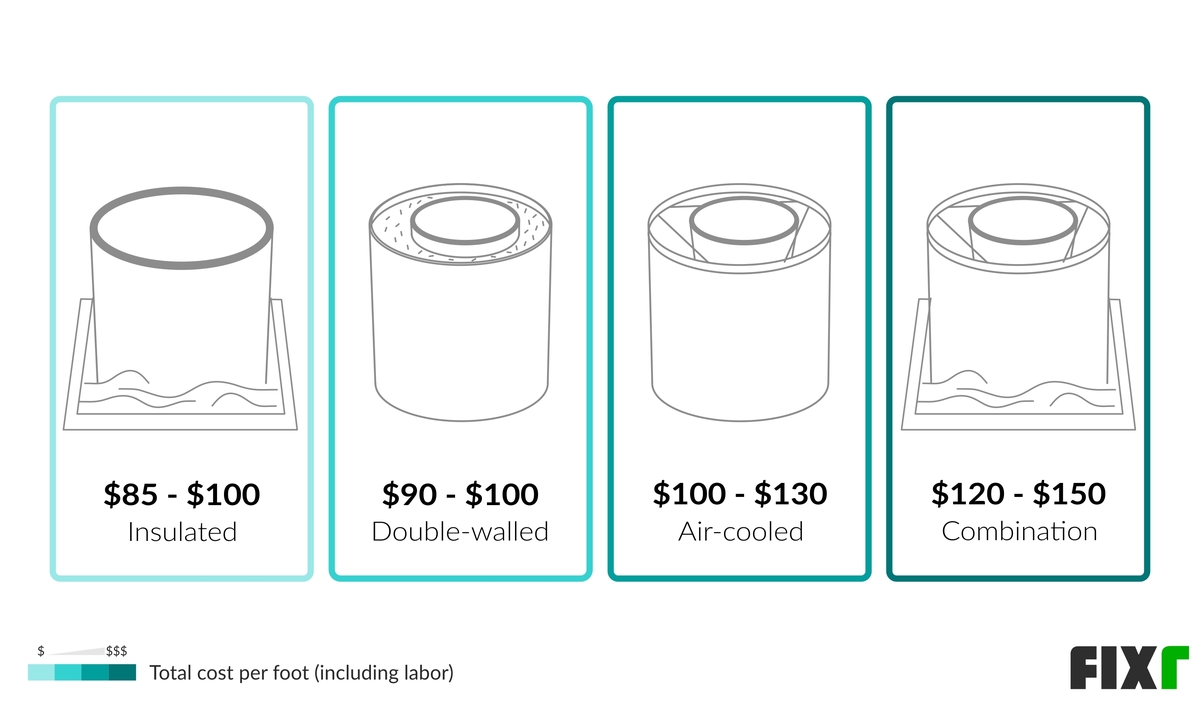Updated: January 31, 2025
To provide you with the most accurate and up-to-date cost figures, we gather information from a variety of pricing databases, licensed contractors, and industry experts.
If you have a fireplace or wood-burning stove in your home or plan to install one of these, you must have a functioning chimney. Chimneys help fireplaces and stoves draw, bringing them fresh air to help combustion while pulling the smoke up and out of your home. They come in many different types and styles and should be customized to the fireplace or stove installed.
The most commonly installed type of chimney in the U.S. is the masonry chimney, made of brick, block, or stone. For a masonry chimney that is 30 feet in height, expect an average cost range between $4,000 and $8,000, with most homeowners paying around $6,500 for the job. For the $6,500 average, the work includes a 30-foot masonry-built chimney. At the lower end, you can secure a prefabricated 30-foot chimney for $3,500. Expect to pay upwards of $11,500 for 30-foot masonry chimneys that include decorative exteriors and copper chimney caps.
Chimney Cost
| Chimney Installation Cost | |
| National average cost | $6,500 |
| Average range | $4,000-$8,000 |
| Low-end | $3,500 |
| High-end | $11,500 |
Prefab Chimney vs Masonry Chimney Cost
The type of chimney you have will be directly related to the kind of fireplace or stove. For example, a masonry fireplace needs a masonry chimney, while a prefab fireplace needs a prefab chimney from the same manufacturer. Many fireplaces and chimneys are not interchangeable, so you should always ensure that what you are installing matches the rest of the materials. To give you a better idea, the below table compares the average costs per foot for prefab and masonry chimneys.


| Type | Average Cost per Foot (Installed) |
| Prefab | $100 - $150 |
| Masonry | $150 - $200 |
Prefab Chimney
If you have a factory-built fireplace, you need to have a factory-built chimney to match, which costs around $100 to $150 a foot. Also called prefabricated chimneys or engineered chimneys, they are built off-site to the exact specifications of your home and fireplace. Expect to pay for a masonry chimney based on the number of flues. Remember that chimneys with multiple flues are typically custom built masonry rather than prefabricated.
Masonry Chimney
Masonry chimneys cost between $150 and $200 a foot and are among the most common types because they are considered the safest. They are constructed out of many different materials created to withstand the heat of a chimney fire and may be lined or unlined. Masonry chimneys may contain one flue, several flues, or no flue at all. They are the most decorative chimney type and most likely to raise your home’s value. However, they are among the most expensive types and require a lot of maintenance, cleaning, and inspections to keep them at their best.
Chimney Construction Cost by Size
The size of the chimney directly impacts how much you’ll spend on the project. Many companies charge based on linear feet. The company evaluates how much materials are needed and gives you a quote based on the overall chimney size. The size of the home determines the chimney height. Most building codes require that the chimney measure at least three feet above where it exits the roof.
You can expect to spend between $100 and $150 per foot for prefab factory-built chimney construction projects and $150 to $200 per foot for masonry work. The pricing does not include any extras such as decorative caps and exterior finishes. The following are the most common chimney sizes that need to be built or newly installed.


| Size | Prefab Average Cost (Labor Included) | Masonry Average Cost (Labor Included) |
| 13 Feet | $1,300 - $1,950 | $1,950 - $2,600 |
| 24 Feet | $2,400 - $3,600 | $3,600 - $4,800 |
| 30 Feet | $3,000 - $4,500 | $4,500 - $6,000 |
| 35 Feet | $3,500 - $5,250 | $5,250 - $7,000 |
| 38 Feet | $3,800 - $5,700 | $5,700 - $7,600 |
Chimney Cost by Number of Flues
Chimney costs increase by the number of flues shared by appliances. For example, if you have a fireplace and use oil or gas to heat your home, you likely have two flues. The cost of chimney installation increases by an average of $1,200 to $2,000 per additional flue. Each flue needs a liner . You will have to purchase a non-standard chimney cap for the structure. In most cases, three flues 4 are the maximum number found in a chimney. The following is the average price you can expect to pay for a masonry chimney based on the number of flues, keeping in mind that chimneys with multiple flues are typically custom-built masonry rather than prefabricated.


| Number of Flues | Average Project Cost (Labor Included) |
| Single | $5,000 - $6,500 |
| Two | $6,500 - $8,000 |
| Three | $8,000 - $9,500 |
Cost to Build Chimney by Fireplace Type
Many different fireplaces are available to choose from, which is a big factor in the overall chimney project cost. Essentially, a fireplace is an open hearth containing fire, situated at the base of a chimney. The fireplace is connected to the actual chimney, a vertical channel that allows smoke and gasses to exit through the roof and keep the indoor air quality safe and clean.
Some fireplaces and their required chimneys are easier to build and install than others, which often comes down to the ventilation and construction/installation requirements for the wall and roof. Also, some fireplaces and stoves are best vented vertically rather than horizontally or vice versa. This depends on the appliance itself, your home design, and any other venting requirements you may have. The below table outlines the average costs of building a chimney by fireplace type.


| Fireplace Type | Cost per Foot to Build Chimney (Labor Included) |
| Wall-Mounted | $100 - $125 |
| Outdoor | $100 - $140 |
| Exterior Wall | $100 - $150 |
| Fireplace Insert | $100 - $200 |
| Freestanding | $105 - $215 |
| Corner | $125 - $170 |
| Peninsula | $150 - $200 |
| Island / Interior Wall | $150 - $220 |
Wall-Mounted Fireplace Chimney
A wall-mounted fireplace chimney costs between $100 and $125 per foot. As the name suggests, these fireplaces are mounted on the wall, so less labor is involved than other types. However, they need to be securely mounted to ensure safe use and aesthetically pleasing interior design. Many electric fireplaces are wall-mounted.
Outdoor Chimney
An outdoor chimney costs about $100 to $140 a foot and is easier to build in some regards because it can be a standalone feature rather than installed within a wall. Outdoor chimneys may be made of metal or brick and do not always need to be as tall as internal chimneys. This depends on the location and size, influencing the final cost.
Exterior Wall (Standard) Fireplace Chimney
For a standard exterior wall fireplace chimney, you can expect to pay somewhere between $100 and $150 per foot. Installing fireplace chimneys on an outside wall is often easier for ventilation purposes than with interior walls, which is why you often see fireplaces toward the back of the house in a living space leading out to the backyard. These standard fireplace chimneys are usually masonry but may come prefabricated, too.
Fireplace Insert Chimney
Fireplace inserts can use a few different types of chimneys, including masonry and, in some cases, factory-built. Therefore, costs vary widely from $100 to $200 a foot on average. This depends largely on the type of insert, whether or not you have an existing firebox, and the firebox’s material. For example, if the firebox is masonry, you will have a masonry chimney to match.
Freestanding Stove Chimney
Freestanding stove chimneys are custom built for the stove and cost between $105 and $215 a foot, depending on the type of chimney. They may also be prefabricated or masonry, depending on your desire, but they are created just for that stove. They are frequently not interchangeable and are designed to fit the pipe of your stove.
Corner Fireplace Chimney
Most homeowners pay $125 to $170 a foot for a corner fireplace chimney. These fireplaces are specially designed to fit into the corner of a room, saving space and adding style at the same time. These chimneys are popular additions to new homes or renovations as they do not normally need an existing fireplace so long as the chimney venting is installed correctly.
Peninsula Fireplace Chimney
A peninsula fireplace chimney costs $150 to $200 a foot and offers a sophisticated interior design with a fireplace dividing two sides of the room. It is attached against the wall on one side and may be made of brick, drywall, stucco, tile, wood, or other wall materials. The more luxurious the finish you select, the higher the price.
Island / Interior Wall Fireplace Chimney
Installing an island or interior wall fireplace chimney costs $150 to $220 per foot, which is higher than many other fireplace types because of the careful construction and support. Your professional chimney installer needs to evaluate the existing kitchen or living room space to determine how much reinforcement is needed for the island or interior wall and whether it can be connected to an existing vent.
Labor Cost to Install a Chimney
Labor makes up a big part of the cost of a chimney. This is especially true for a masonry chimney, where the materials are fairly inexpensive. However, the labor to put them together can be very time-consuming. For an engineered fireplace, the labor is the lower part of the equation, with the materials being the more expensive piece.
Labor for a masonry chimney ranges between $80 and $95 per foot. Costs can be higher for more decorative exteriors. For example, a fieldstone chimney installed on the side of the home will have a lot more decorative work done than a masonry chimney installed in the center of a house with only the above-roof portion visible. Likewise, the pitch of the roof and height of the chimney above the roofline impact the cost. Roofs with a high pitch are more difficult to work on and require additional flashing around the edges. For a masonry chimney measuring 30 feet, the average labor cost is around $2,700 out of the $6,500 total.
Building a chimney is a long, complicated process that involves several different professionals. A concrete pad is poured where the chimney will begin, which is often behind the fireplace itself. Fire brick or fire blocks are used to start building the chimney, which may need to be supported at various points during construction by lumber scaffolding. The flue is constructed inside the blocks, with holes drilled at strategic places to allow for a better draw. A liner made of metal or clay tiles is installed on the chimney’s interior for protection. The finished material is installed over any visible parts of the chimney, either the portion that extends past the roofline or the exterior visible from the side of the home. Because precise angles are needed to reach from the firebox to the flue, and ultimately to the roof, each chimney is built specifically for the fireplace and home.
Chimney Replacement Cost
Chimney replacement is a requirement in certain scenarios. Full chimney replacement costs significantly more than new installations because the old chimney must go through demolition. After demolition, the leftover materials must be removed and discarded by a professional. Demolition and chimney removal costs around $500 to $3,500 depending on the size of the structure. After paying the chimney removal cost, replacing a chimney will average around $4,000 to $10,000. Metal chimney replacement will have pricing on the lower end of the range, while masonry types have a higher expense.
As an alternative to chimney replacement, the homeowner may hire a contractor to rebuild the chimney. Since part of the chimney can be salvaged, costs are reduced. With a chimney rebuild, a new foundation doesn’t need to be poured, and a structural engineer doesn’t need to be hired for a redesign. Depending on how much it needs rebuilding, you may pay around $1,000 to $3,500 for labor and materials.
Prefab Chimney Prices by Type of Insulation
Chimney replacement is a requirement in certain scenarios. Full chimney replacement costs significantly more than new installations because the old chimney must go through demolition. After demolition, the leftover materials must be removed and discarded by a professional. Demolition and chimney removal costs around $500 to $3,500 depending on the size of the structure. After paying the chimney removal cost, replacing a chimney will average around $4,000 to $10,000. Metal chimney replacement will have pricing on the lower end of the range, while masonry types have a higher expense.
As an alternative to chimney replacement, the homeowner may hire a contractor to rebuild the chimney. Since part of the chimney can be salvaged, costs are reduced. With a chimney rebuild, a new foundation doesn’t need to be poured, and a structural engineer doesn’t need to be hired for a redesign. Depending on how much it needs rebuilding, you may pay around $1,000 to $3,500 for labor and materials.


| Factory-Built Type | Cost per Foot (Labor Included) |
| Insulated | $85 - $100 |
| Double-Walled | $90 - $100 |
| Air-Cooled | $100 - $130 |
| Combination | $120 - $150 |
Do You Need a Chimney?
One of the most common doubts for homeowners is whether or not they actually need a chimney. If you have just moved into a new place or are just installing a new appliance, you may be unsure if you need a chimney or if other forms of venting are sufficient. Thanks to modern building practices, you can manage without a chimney for more heating systems. However, there are still many cases where a chimney makes the most sense. It truly depends on the design of your home, any existing appliances, and the new heating system you are installing. Because chimney requirements vary so greatly in each home, it is important to speak to a professional to determine how extensive a chimney installation would be with your new appliances and whether or not you need one.
While traditional gas fireplaces and wood stoves required chimneys for proper venting, today, more models use alternative venting systems or even come vent-free to eliminate the need. Ethanol, gel, and electric fireplaces do not need a chimney at all, while pellet stoves and boilers either need a chimney or a side wall vent. The same goes for water heaters that need to be vented via a chimney or power vents. You need to check your specific appliance and contact a trusted professional to understand if you need a chimney or could use other types of ventilation. If you have an existing chimney, you most likely need to keep it or arrange for your appliances to be vented differently.
Pros and Cons
Chimneys have been used for centuries as a means to vent out heat and gases from a home. However, modern appliances make it possible to forgo a chimney altogether. Some types of fireplaces don’t need a chimney for operation. The following are key chimney benefits and drawbacks.
One of the main chimney benefits is that most homes come standard with a chimney. The chimney can be used to vent appliances and fireplaces without performing major structural changes to the home. Many home appliances are designed to be vented through a chimney, including water heaters, furnaces, fireplaces, boilers, and wood-burning stoves. Chimneys are fairly easy to maintain. Homeowners normally perform an annual chimney inspection and chimney cleaning to confirm everything is in good working condition.
Chimney disadvantages include the possibility of any repairs and replacement work that must be done. Many chimneys built decades earlier may need to have updates like a new chimney liner installation. If you have issues with moisture or wildlife entering a home through a chimney, you may need to install a chimney cap on the roof. High-efficiency appliances usually no longer require a chimney for venting purposes. Instead, the appliances rely on pipe venting systems.

Chimney Maintenance Cost
If you use your fireplace or woodstove at all, you need to have your chimney cleaned and inspected yearly. This costs between $100 and $500, depending on the number of flues and the level of cleaning and inspection required. During this cleaning, the chimney sweep looks for cracks in the liner, missing mortar, and other issues that should be dealt with promptly to ensure that your chimney stays in good condition. A cursory inspection is part of your cleaning, but occasionally, you need a more in-depth inspection to discover the cause of a problem. More thorough inspections cost between $100 and $500 with a basic cleaning.
Chimney maintenance is also the responsibility of the homeowner. Keep fireplaces clean and remove ashes after cooling. Only use seasoned wood in a fireplace or approved types from the Chimney Safety Institute of America. During the colder seasons, clean the firebox at least weekly.

Chimney Crown vs Cap
Whichever type of chimney you have, you want to protect it from moisture, snow, and small animals. Two different systems allow you to do this--a crown and a cap.
Crowns are made from leftover mortar from a masonry chimney and are often included in the cost of the chimney. No additional cost is incurred for a chimney crown. They cover the entire top of the chimney but not the flue. They still allow water and animals to enter and do not offer much protection. They crack over time. Chimney crown installation will be $1,000 to $3,000 if a replacement is needed in the future.
Many homeowners choose to pair chimney crowns with chimney caps, which form a cage over the top of the chimney while being open on the sides. This keeps rain out more effectively and gives the chimney various appearances, depending on the style and material used. A chimney cap installation cost will be around $300 to $600. They protect the chimney and prolong its life. They are recommended even for chimneys with crowns.


| Element | Average Cost (Labor Included) |
| Cap | $300 - $600 |
| Crown | $1,000 - $3,000 |
Enhancement and Improvement Costs
Chimney Sealing
If desired, you may wish to seal your chimney to effectively waterproof it and prevent water damage that could weaken the structure. This can be done in sections or for the entire chimney. Costs depend on the part being sealed. Typical chimney waterproofing costs start at around $170 and go up to $400 depending on the size and type of chimney.
Elastomeric Coating
An elastomeric coating helps seal your chimney and prevents damage to the bricks or exterior material. The coating is flexible, so it absorbs some movement from the home, saving the mortar in the masonry. It costs around $80 to $120 on average.
Chimney Extension
Chimney extension refers to increasing the height of your current chimney. In some cases, a chimney may need to be raised one to three feet higher to satisfy modern building codes. A chimney extension improves ventilation. Chimney extensions range from $900 to $3,000, depending on the height and material used for the project.
Additional Considerations and Costs
- Ventless fireplace. If you want to have a fireplace but not a chimney, install an electric fireplace. They do not require chimneys but still add a lot of aesthetic value to a room.
- Permits. You may need a permit to install a chimney in many areas. Always check with your town or city hall to find out.
- Outdoor fireplace. If you want to have an outdoor fireplace, use a chiminea or clay fireplace with an attached chimney. They can be placed anywhere to give you a safely burning fire that draws like an interior fireplace and chimney.
- Trapped animals. Without a chimney cap, you may sometimes get small animals trapped in a chimney. This may sound like scrabbling, banging, or squeaking coming from inside the chimney. If you suspect an animal may be trapped, try lowering a rope down the flue, which gives them a way to climb out.
- Repoured foundation. Chimneys may require a repoured foundation. Chimneys weigh more than a ton and a half. A structural engineer may need to confirm that the foundation is sound before a rebuild or replacement.
- Metal chimneys. You are most likely to find a metal chimney on an older home or commercial building. They are much less common in newer residential homes because they are not as safe or attractive. They may be single-wall or double-wall in construction and are most commonly round, although they can be square. They cost around $75 to $100 a foot.
- Wood stove chimney. This type of chimney looks a great deal like a masonry chimney. However, this chimney is designed to house the stove pipe for your wood stove and vent it. Even though it appears similar, it is a little more complex than a masonry chimney. It is also designed out of fire brick or material designed to handle the heat of the fire. They cost between $175 and $350 a foot.
FAQs
- Does a chimney add value to a house?
According to recent home buyer surveys, 68% of buyers want a fireplace in a new home. This means the inclusion of a chimney with a fireplace adds value.
- Why do houses have chimneys but no fireplace?
Not all homes with chimneys have fireplaces. The home may be using the chimney with an appliance. If no appliance is using the chimney, the structure can be removed.
- How tall does a wood stove chimney need to be?
Any chimney must be at least 3 feet off your roofline and 2 feet taller than anything within 10 feet of the chimney.
- Does a wood stove chimney have to go straight up?
It is always best if a wood stove chimney runs straight up. However, at least 80% of the chimney should be vertical. If necessary, one or two 45 degree angles can be incorporated.
- Do wood-burning stoves need a chimney?
You do not necessarily need a chimney for all wood-burning stoves. It depends on any existing ventilation and how the new appliance can be vented. Many homeowners still opt for a wood-burning stove with a chimney.
- Do you need a chimney for a log burner?
Not all log burners and pellet stoves need a chimney, particularly in modern homes. However, it depends on the specific appliance and building design.
- How far does a chimney need to be from a window?
A chimney should be at least 3 feet from windows and have that much space between the top of the chimney and the roof.
- Can I have a fireplace without a chimney?
Yes, it is possible to have a fireplace without a chimney, particularly if you opt for an ethanol, electric, or gel fireplace that does not need one. Otherwise, some gas and wood fireplaces may not need chimney venting, depending on the design.
